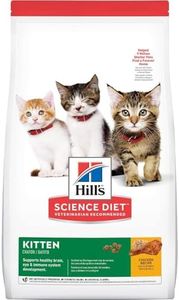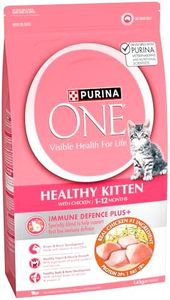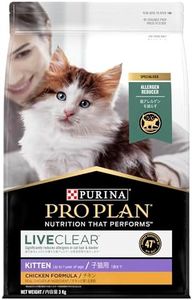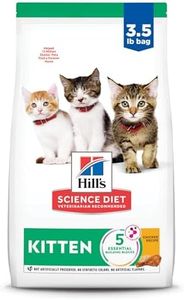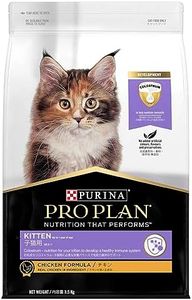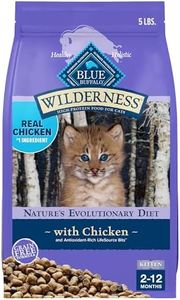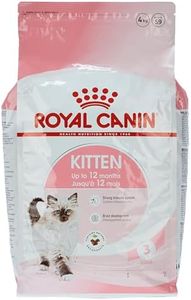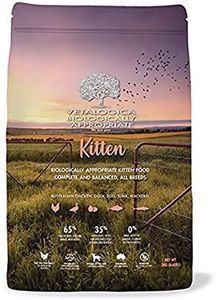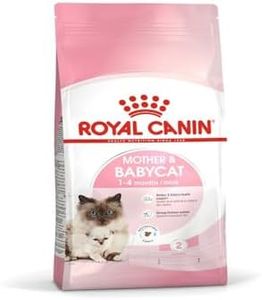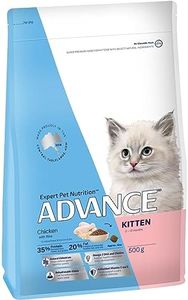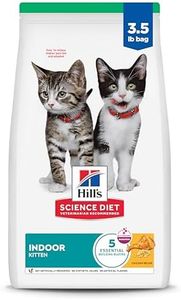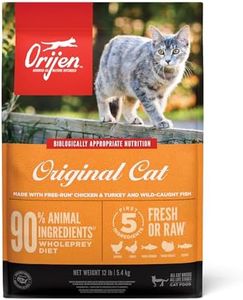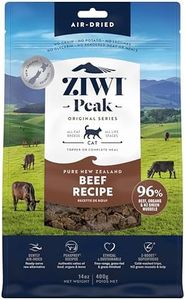We Use CookiesWe use cookies to enhance the security, performance,
functionality and for analytical and promotional activities. By continuing to browse this site you
are agreeing to our privacy policy
10 Best Dry Kitten Foods
From leading brands and best sellers available on the web.Buying Guide for the Best Dry Kitten Foods
Choosing the right dry kitten food is essential for your growing pet’s health and happiness. Kittens need different nutrition than adult cats, so selecting a food specially formulated for their needs is important. When shopping, focus on understanding the information on the packaging: it can sometimes be overwhelming with lots of nutritional claims, so knowing what truly matters will help you make a great choice. Consider your kitten’s age, activity level, and any sensitivities or preferences. Always introduce new food gradually, watch how your kitten responds, and consult your veterinarian if you’re unsure.Protein ContentProtein is the building block for a kitten’s muscles and overall growth. Kitten food will always have higher protein levels compared to adult cat food. Generally, protein content ranges from about 30% to over 40%. Foods at the lower end might be suitable for less active kittens, but for most growing kittens, a higher protein percentage ensures they get what they need for strong development. If you have a particularly playful or energetic kitten, opting for food with higher protein can be beneficial.
Fat ContentFat supplies the energy that kittens need for play, growth, and learning. Good dry kitten foods usually have a fat content in the range of 15-25%. Lower-fat foods might suit kittens prone to digestive issues, but most will benefit from a moderate-to-high fat diet, especially active ones. Choose a food with balanced fat to keep your kitten sprightly and to support brain and vision development.
DHA and Omega Fatty AcidsDHA and other omega fatty acids are essential for brain, vision, and skin development in kittens. Some foods highlight these nutrients as key benefits. Higher levels are found in formulas focusing on brain and eye development. If you want to support cognitive growth and a shiny coat, pick a food that clearly states the inclusion of DHA or omega fatty acids.
Vitamin and Mineral BalanceKittens need the right mix of vitamins and minerals—like calcium, phosphorus, and vitamin D—for healthy bone growth and immunity. Some foods may boost specific vitamins, but generally, kitten food should be labeled as ‘complete and balanced’ which means all necessary nutrients are included. If your kitten is growing rapidly or has been unwell, paying more attention to balanced nutrition is even more important.
Kibble Size and TextureDry food comes in different shapes and sizes, which can matter for tiny kitten mouths. Smaller kibble is easier to chew and can encourage kittens just starting to eat solid food. If your kitten struggles with large, hard pieces, choose food with a smaller, softer kibble designed for kittens’ tiny teeth.
Ingredient QualityIngredient quality impacts digestibility and overall health. Foods with named animal proteins (like chicken or salmon) as the first ingredients are generally best. Avoid foods with vague or overly processed ingredients. If your kitten has a sensitive stomach, look for formulas that specify gentle or limited ingredients.
Added Probiotics and PrebioticsProbiotics and prebiotics support healthy digestion. Some dry kitten foods include these to help balance gut health, which can be especially helpful during the transition from milk to solids. If your kitten has loose stools or a sensitive tummy, choosing food with added probiotics and prebiotics can make a positive difference.
